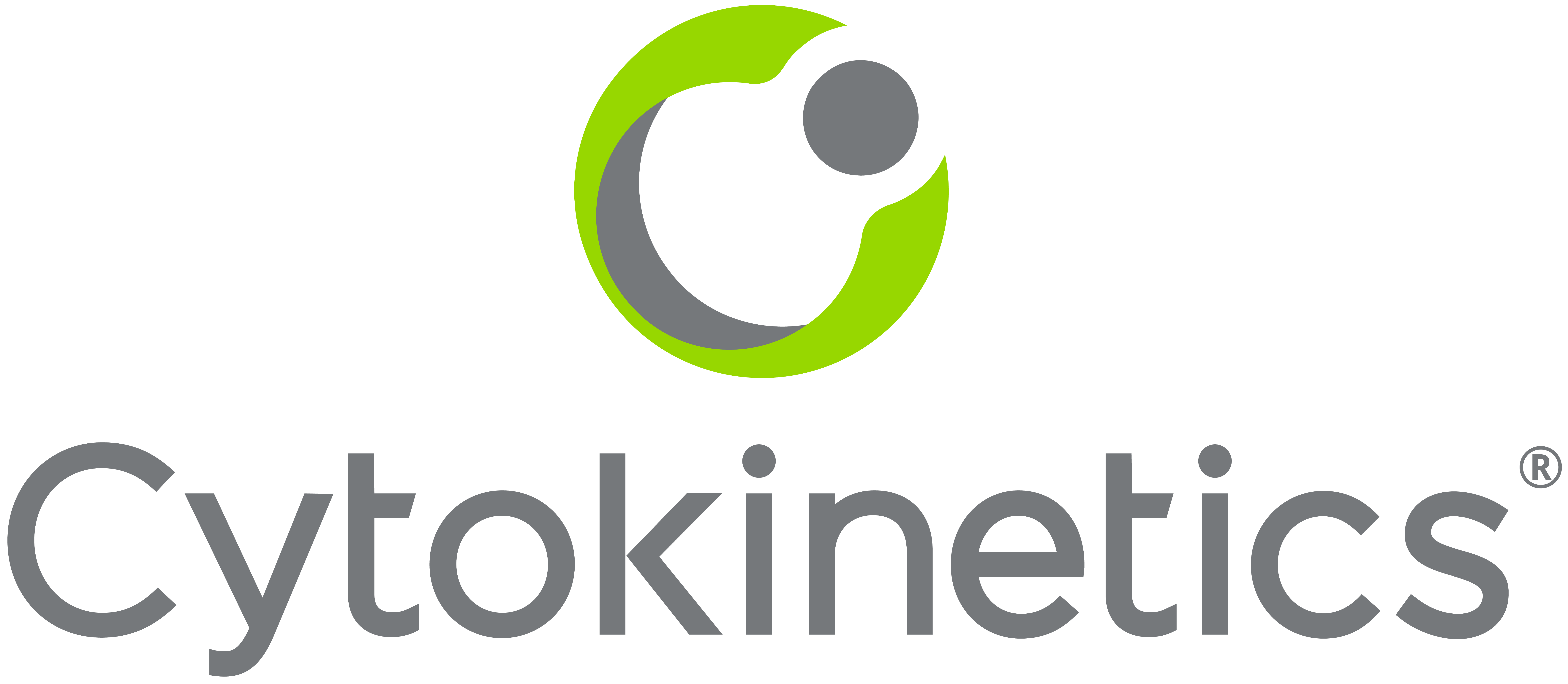Cytokinetics Announces Results From METEORIC-HF and Additional Data From GALACTIC-HF Presented at the American College of Cardiology 71st Annual Scientific Session
No Effect of Omecamtiv Mecarbil On Exercise Capacity
in Patients with Heart Failure with Reduced Ejection Fraction in METEORIC-HF
Healthcare Resource Utilization and Cost Analysis from GALACTIC-HF Demonstrate Treatment with Omecamtiv Mecarbil Led to 19% Cost Reduction Per Patient in Key Subgroup
Additional Results from GALACTIC-HF Indicate Treatment with Omecamtiv Mecarbil
Associated with Similar Risk Reduction in Both Hospitalized Patients and Outpatients
METEORIC-HF: No Effect of Treatment with Omecamtiv Mecarbil on Exercise Capacity
METEORIC-HF evaluated the effect of treatment with omecamtiv mecarbil compared to placebo on exercise capacity as determined by cardiopulmonary exercise testing (CPET) following 20 weeks of treatment in patients with HFrEF receiving standard of care therapy. The trial enrolled 276 patients in 9 countries. At baseline, patients had an average left ventricular ejection fraction (LVEF) of 27% and an average peak oxygen uptake (pVO2) of 14.7 ml/kg/min; 79% were
GALACTIC-HF: Treatment with Omecamtiv Mecarbil Led to 19% Cost Reduction Per Patient Among Patient Subgroup with Ejection Fraction Less than 30%, Without Atrial Fibrillation and Digoxin
GALACTIC-HF: Treatment with Omecamtiv Mecarbil Associated with Similar Risk Reduction in the Primary Composite Endpoint in Both Hospitalized Patients and Outpatients
The rate of the primary outcome was higher in hospitalized patients in the placebo group (38.3/100 person-years [PY]) than in outpatients (23.1/100 PY) with an adjusted hazard ratio (HR) of 1.21 (95% CI 1.12, 1.31). There was a stepwise gradient in risk, with those randomized as outpatients in the placebo group within 3 months of a heart failure event at the highest risk (26.6/100 patient years (PY)) as compared with those 9-12 months post-event (19.0/100 PY) with an adjusted hazard ratio (HR) of 1.20 (95% CI 1.01, 1.42), p for trend = 0.008). The effect of omecamtiv mecarbil versus placebo on the primary outcome was similar in hospitalized patients (HR 0.89, 95% CI 0.78, 1.01) and outpatients (HR 0.94, 95% CI 0.86, 1.02), indicating that omecamtiv mecarbil similarly reduced the risk of the primary outcome both when initiated in hospitalized patients and in outpatients. In both hospitalized patients and outpatients, the initiation of omecamtiv mecarbil was safe and well tolerated. Treatment-emergent serious adverse events occurred more frequently in patients randomized during hospitalization but did not differ significantly between the treatment groups.
“The results of METEORIC-HF continue to emphasize the difficulty of improving exercise capacity in patients with heart failure and reduced ejection fraction even as strides are made to improve clinical outcomes in these same patients. While there was no effect of omecamtiv mecarbil on exercise capacity in METEORIC-HF, we are encouraged that the results further reinforce the overall safety profile of omecamtiv mecarbil observed in GALACTIC-HF,” said
About Omecamtiv Mecarbil
Omecamtiv mecarbil is an investigational, selective, small molecule cardiac myosin activator, the first of a novel class of myotropes1 designed to directly target the contractile mechanisms of the heart, binding to and recruiting more cardiac myosin heads to interact with actin during systole. Omecamtiv mecarbil was designed to increase the number of active actin-myosin cross bridges during each cardiac cycle and consequently augment the impaired contractility that is associated with heart failure with reduced ejection fraction (HFrEF). Preclinical research has shown that omecamtiv mecarbil increases cardiac contractility without increasing intracellular myocyte calcium concentrations or myocardial oxygen consumption.2-4
The development program for omecamtiv mecarbil is assessing its potential for the treatment of HFrEF. Positive results from GALACTIC-HF, the first Phase 3 clinical trial of omecamtiv mecarbil demonstrated a statistically significant effect of treatment with omecamtiv mecarbil to reduce risk of the primary composite endpoint of cardiovascular (CV) death or heart failure events (heart failure hospitalization and other urgent treatment for heart failure) compared to placebo in patients treated with standard of care. No reduction in the secondary endpoint of time to CV death was observed. Adverse events and treatment discontinuation of study drug were balanced between treatment arms. The FDA has accepted for filing the NDA for omecamtiv mecarbil based on the results from GALACTIC-HF and has assigned a Prescription Drug User Fee Act (PDUFA) date of November 30, 2022.
About Heart Failure
Heart failure is a grievous condition that affects more than 64 million people worldwide1 about half of whom have reduced left ventricular function.2,3 It is the leading cause of hospitalization and readmission in people age 65 and older.4,5 Despite broad use of standard treatments and advances in care, the prognosis for patients with heart failure is poor.6 An estimated one in five people over the age of 40 are at risk of developing heart failure, and approximately 50 percent of people diagnosed with heart failure will die within five years of initial hospitalization.7,8 More than 2 million people in the U.S. are estimated to have an ejection fraction <30%, indicating they may have severe heart failure.9
About
Cytokinetics is a late-stage biopharmaceutical company focused on discovering, developing and commercializing first-in-class muscle activators and next-in-class muscle inhibitors as potential treatments for debilitating diseases in which muscle performance is compromised. As a leader in muscle biology and the mechanics of muscle performance, the company is developing small molecule drug candidates specifically engineered to impact muscle function and contractility. Cytokinetics is readying for the potential commercialization of omecamtiv mecarbil, its cardiac muscle activator, following positive results from GALACTIC-HF, a large, international Phase 3 clinical trial in patients with heart failure. Cytokinetics is also developing aficamten, a next-generation cardiac myosin inhibitor, currently the subject of SEQUOIA-HCM, the Phase 3 clinical trial of aficamten in patients with symptomatic obstructive hypertrophic cardiomyopathy (HCM). Aficamten is also being evaluated in non-obstructive HCM in Cohort 4 of the Phase 2 clinical trial, REDWOOD-HCM. Cytokinetics is also developing reldesemtiv, an investigational fast skeletal muscle troponin activator, currently the subject of COURAGE-ALS, a Phase 3 clinical trial in patients with amyotrophic lateral sclerosis (ALS). Cytokinetics continues its over 20-year history of pioneering innovation in muscle biology and related pharmacology focused to diseases of muscle dysfunction and conditions of muscle weakness.
For additional information about
Forward-Looking Statements
This press release contains forward-looking statements for purposes of the Private Securities Litigation Reform Act of 1995 (the "Act").
CYTOKINETICS® and the
Contact:
Associate Director, Corporate Communications, Investor Relations
(650) 624-3283
References:
- Psotka MA, Gottlieb SS, Francis GS et al. Cardiac Calcitropes, Myotropes, and Mitotropes. JACC. 2019; 73:2345-53.
- Planelles-Herrero VJ, Hartman JJ, Robert-Paganin J. et al. Mechanistic and structural basis for activation of cardiac myosin force production by omecamtiv mecarbil.
Nat Commun . 2017;8:190. - Shen YT, Malik FI, Zhao X, et al. Improvement of cardiac function by a cardiac myosin activator in conscious dogs with systolic heart failure. Circ Heart Fail. 2010; 3: 522-27.
- Malik FI, Hartman JJ, Elias KA, Morgan BP, Rodriguez H, Brejc K, Anderson RL, Sueoka SH, Lee KH, Finer JT, Sakowicz R. Cardiac myosin activation: a potential therapeutic approach for systolic heart failure. Science. 2011 Mar 18;331(6023):1439-43.
- James et al. GBD 2017 Disease and Injury Incidence and Prevalence Collaborators.
Lancet 2018; 392: 1789–858. - Yancy CW, Jessup M, Bozkurt B, et al. 2013 ACCF/AHA Guideline for the Management of Heart failure: A Report of the American College of Cardiology Foundation/American Heart Association Task Force on Practice Guidelines. Circulation. 2013;128:e240-e327.
- Ponikowski P, Voors AA, Anker SD, et al. 2016 ESC guidelines for the diagnosis and treatment of acute and chronic heart failure: The Task Force for the diagnosis and treatment of acute and chronic heart failure of the European Society of Cardiology (ESC). Developed with the special contribution of the Heart Failure Association (HFA) of the ESC. Eur Heart J. 2016;37:2129–2200.
- Roger VL. Epidemiology of Heart Failure.
Circulation Research . 2013;113:646-659, originally published August 29, 2013. Doi: 10.1161/CIRCRESAHA.113.300268. - Kilgore M, Patel HK, Kielhorn A et al. Economic burden of hospitalizations of Medicare beneficiaries with heart failure. Risk Manag Healthc Policy. 2017; 10: 63-70.
- Jhund PS, MacIntyre K, Simpson CR, et al. Long-Term Trends in First Hospitalization for Heart Failure and Subsequent Survival Between 1986 and 2003. Circulation. 2009;119:515-523.
- Benjamin EJ, Virani SS, Callaway CW et al. Heart Disease and Stroke Statistics—2018 Update: A Report From the American Heart Association. Circulation. 2018;137:e67-e492.
- Roger VL, Weston SA, Redfield MM, et al. Trends in Heart Failure Incidence and Survival in a Community-Based Population. JAMA. 2004;292:344-350.
- Shannon M. Dunlay, Véronique L. Roger, Susan A. Weston, Ruoxiang Jiang, and Margaret M. Redfield (Circ Heart Fail. 2012;5:720-726.); Olmsted County community cohort of HF patients (1984 to 2009).

Source: Cytokinetics, Incorporated




